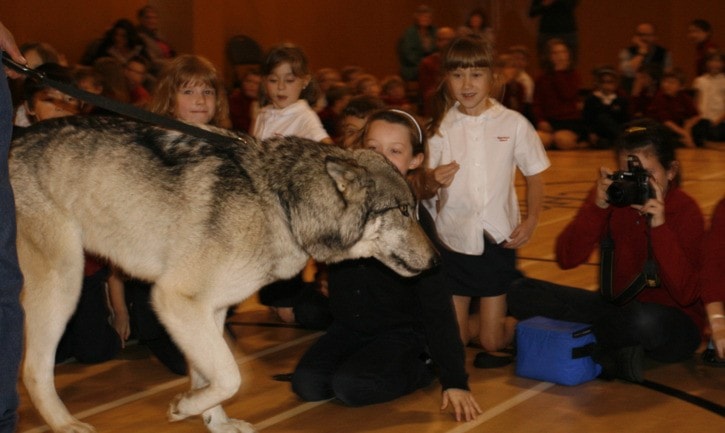Students at West-Mont school had a hands-on, close up look at a wolf Thursday as part of an ongoing conservation effort to protect the animal.
Gary Allan, known as the Wolfman, brought his wolf Tundra to the school to help teach kids the value of wolves in the ecosystem, and to rehabilitate their image. Just because it’s a wolf, “doesn’t mean it’s the big, bad wolf,” he said.
Allan toured the four-year-old, 85-pound wolf though the gym. Students had a change to pet the 85-per-cent wolf (15 per cent malamute) and a few were even lucky enough to get a kiss.
Allan raised Tundra from a pup and has toured the animal though different schools for three years. A wild wolf will kill prey such as a deer. Tundra eats a grainless kibble and chicken.
“I want to show them that this is not the big bad wolf,” he said. “It gives them an appreciation of what this animal is about, and that it’s not being demonized as it has been.”
Allan, who also has an eight-year-old male wolf named Meshach, lives with his wife and wolves on Malcom Island near Port McNeill. He was in Victoria with Montana-based wolf biologist Cristina Eisenberg to give a talk at the Royal B.C. Museum for wolf awareness week.
Eisenberg told the students about her work studying and tracking wolves in Canada and the U.S., and shared some wolf history. For decades wolves were hunted for pelts and shot as a threat to livestock. As wolves disappeared, forest ecosystems changed.
“In the early 20th century we all believed the only good predator was a dead one,” Eisenberg said.
Without wolves, animals such as elk and deer can flourish and consume an enormous volume of plant vegetation, she explained. When wolves either return or are reintroduced to areas, trees, shrubs and other plants begin to reclaim the landscape as elk and deer population are reduced and are forced to stay on the move.
“Wolves are a keystone predator and they affect how things grow and the changes that happen,” Eisenberg said.
Wolves and prey tend to find a balance, she continued. Wolves won’t wipe out other animal populations.
“Elk can always outrun a wolf,” Eisenberg said, explaining a wolf can run about 38 miles per hour and elk can run 45 miles per hour. “The elk has to make a dumb choice (to get caught).”
reporter@goldstreamgazette.com
